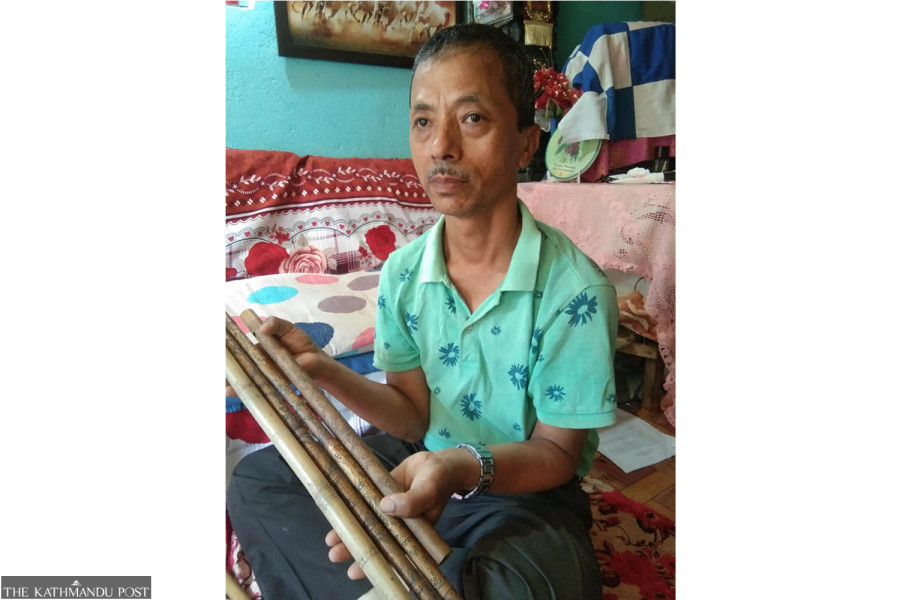Culture & Lifestyle
A dying tradition
Basantajung Rajbhandari, one of the few remaining Buttenali artists, has spent forty-two years preserving this unique art form.
Prakash Baral
Buttenali is a symbol of Baglung’s identity. For three or four generations, only the painters from Baglung have been known for their expertise in creating this art form. Due to this, Baglung is often referred to as the “District of Buttenali” in various textbooks. Today, only one living painter from the region continues to preserve this tradition, though he mentioned that he couldn’t pursue it professionally.
58-year-old Basantajung Rajbhandari, a resident of Baglung Municipality-3, is one of the few remaining Buttenali artists. In his youth, he devoted countless hours to perfecting the craft. However, he eventually became a teacher by profession. He first learned to carve designs into Nigalo in 1982 while still in the 8th grade, under the guidance of Chamunarayan Guvaju. Of all Guvaju’s many students, he is the only one who continues this intricate work.
Unlike his peers, Rajbhandari has not forgotten his craft despite being a professional teacher. He has made efforts to pass on his skills to the younger generation. However, he regrets that the youth have yet to embrace the demanding manual labour involved in the art.
Buddam, Rajbhandari’s youngest son, occasionally carves designs in Nigalo. However, he has lost touch with his craft since he went to Chennai, India, to study computer engineering. He carves a few designs when he visits home, but his involvement still needs to be improved.
Rajbhandari also shared his skills with prison inmates, teaching them the art of Buttenali over 45 days. While a few of them have taken up the craft sporadically after their release, the impact has been limited. The Nepal Handicraft Association recognised Rajbhandari’s expertise and appointed him a workshop trainer. However, he believes that most participants haven’t fully mastered the craft.
In 1989, Rajbhandari showcased Buttenali at a national handicraft exhibition in Kathmandu. The then-politician Rabindranath Sharma praised his work and purchased the sticks he had brought to the event. Rajbhandari recalls that Sharma also encouraged the district-level domestic and small industry development committee to support his products by buying them.
Entering this profession is a challenging task. Butta designs can only be drawn in bright light, usually during the morning and noon. Poor lighting makes it difficult to work, and any mistake can ruin an entire week’s effort. “You must be extremely careful and fully focused,” Rajbhandari explained. “The work puts a lot of strain on the eyes, so mild headaches are common,” he added.
Not all varieties of Nigalo are suitable for carving designs. Rajbhandari says only the thick ‘Malunge’ and ‘Gazing’ varieties are ideal. These types of Nigalo are found exclusively in the western region near Ghumte Lake in Galkot.
“Nigalo should be cut only during the month of Mangsir,” he said. “After cutting, it must be washed with soapy water and thoroughly dried to prevent insects from damaging the carved designs.”

There is a belief that if Nigalo is chopped on an unlucky day, it will attract insects. To further protect it, oil is applied to make the Nigalo smooth. Since this specific type of Nigalo is only found in some places, Rajbhandari occasionally orders it from areas like Badigad, Dhorpatan, and Tamankhola in Baglung.
Basanta’s father, Bhimsen Rajbhandari, was a teacher in the Dhorpatan area and used to bring Nigalo from there. Basant explained that it takes seven to 10 days to complete the designs on a one-and-a-half-meter Nigalo. After the carving, the design is treated with ground charcoal soaked in oil. The areas where the iron knife has etched the design turn black, while the rest of the surface remains yellow or white. His detailed work, which takes up to 10 days, has fetched Rs10,000.
Although Rajbhandari earned a decent income by selling his work to foreigners, he regrets that he couldn’t promote it widely. “If we could effectively promote this art internationally, Nepal would gain recognition on the global stage. Small items could sell for high prices. If Buttenali gained traction abroad, it might inspire our youth to engage in this work,” Rajbhandari remarked.
Baglung Municipality has shown interest in conserving Buttenali, but the younger generation's lack of enthusiasm has hampered efforts. “We’re trying to pass on these skills, but we haven't been successful,” said city chief Basant Kumar Shrestha.
Rajbhandari estimates that he has created and sold over 5,000 Buttenalis. “I haven’t kept an exact count, but I believe I’ve sold more than 5,000,”he said.




 14.12°C Kathmandu
14.12°C Kathmandu.jpg)















